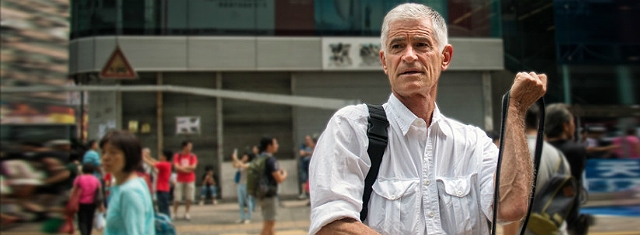Arts
US photojournalist James Nachtwey wins the 2016 Princess of Asturias Award
For Communication and Humanities

James Nachtwey (Source: FPA)
USPA NEWS -
Photojournalist James Nachtwey has been bestowed with the 2016 Princess of Asturias Award for Communication and Humanities, as made public Thursday in Oviedo (Spain) by the Jury responsible for conferring said Award.
This candidature was put forward by Jordi Rodríguez Virgili, Vice Dean of the Faculty of Communication at the University of Navarra (North of Spain). James Nachtwey (Syracuse, New York, 14th March 1948) studied Art History and Political Science at Dartmouth College, where he graduated in 1970. Images from the Vietnam War and the American Civil Rights movement had a powerful effect on him and were instrumental in his decision to become a photographer.
He has worked aboard ships in the Merchant Marine and, while teaching himself photography, he was an apprentice news film editor and a truck driver. In 1976, he started work as a newspaper photographer in New Mexico and, in 1980, moved to New York to begin a career as a freelance magazine photographer. He has been a contract photographer with Time Magazine since 1984 and was associated with the photo agency Black Star from 1980 to 1985. He was a member of Magnum Photos between 1986 and 2001 and co-founded the photo agency VII in 2001.
Four decades of work in war zones, refugee camps, cities devastated by earthquakes or floods or subjected to terrorist attacks anywhere in the world have made James Nachtwey one of the most renowned and respected photojournalists and war reporters working in the field of journalism. Since his first international assignment covering the civil conflict in Northern Ireland during the IRA hunger strike in 1981, Nachtwey has compiled wide-ranging photographic reports.
These have covered armed conflicts (El Salvador, Nicaragua, Guatemala, Lebanon, Gaza and the West Bank, Israel, Haiti, Uganda and Chechnya), the devastation left by civil conflict (Afghanistan), genocide (Rwanda), fratricide (the Balkans), repression (South Africa), poverty (Sri Lanka) and environmental degradation (Eastern Europe), among others issues. In all, he has travelled to more than thirty countries, using his camera to portray armed conflict and humanitarian crises.
Admirer of Goya
An admirer of Goya´s engravings, which he states marked out the way for him, Nachtwey´s mostly black and white photographs do not shy away from the starkness of horror and injustice, but rather reveal it from a position of closeness and respect, with the firm objective of provoking a reaction in the viewer faced by genocide, hunger, poverty and the suffering of others. Among Nachtwey´s photos that have become iconic is the close up in profile he took of a young Hutu in Rwanda in 1994 whose face was criss-crossed by the scars of machete blows, a photo that earned him the World Press Photo of the Year Award that year.
His work has been shown in individual exhibitions in settings such as the International Center of Photography, New York; the National Library of France, Paris; the Palazzo delle Esposizioni, Rome; the Círculo de Bellas Artes, Madrid; the Museum of Photographic Arts, San Diego; the Culturgest, Lisbon; the Massachusetts College of Art, Boston; the Nieuwe Kerk, Amsterdam; and the Carolinum and Hasselblad Center, Gothenburg.
He has published the books Deeds of War (1989), in which he portrays the conflicts he covered between 1981 and 1988; Inferno (1999), a selection of photos taken between 1990 and 1999 of famine in Somalia, genocide in Rwanda, the wars in Bosnia and Chechnya, abandoned orphans in Romania and India´s “untouchables“; and Pietas (2013), a compendium of his best photos.
Protagonist of the documentary War Photographer by Christian Frei (2001), he holds an honorary degree from the University of Massachusetts and an Honorary Fellowship from the Royal Photographic Society (UK). Among others distinctions, Nachtwey has received the Robert Capa Medal from the Overseas Press Club of America (OPC) on five occasions (1992, 1993, 1998, 2001 and 2008), the Magazine Photographer of the Year Award seven times (1984, 1987, 1989, 1991, 1993, 1995 and 2002), the Infinity Award from the International Center of Photography, New York, three times (1989, 1993 and 2000), the World Press Photo twice (1992 and 1994) and the French Prix Bayeux-Calvados for War Correspondents on two occasions.
As stated in the Statutes of the Foundation, the Princess of Asturias Awards are aimed at rewarding “the scientific, technical, cultural, social and humanitarian work carried out at an international level by individuals, institutions or groups of individuals or institutions.“ In keeping with these principles, the Princess of Asturias Award for Communication and Humanities shall be conferred on those “whose creative and investigative work in any type of humanistic activity or in any activity related to social communication, within the framework of the sciences and disciplines that both fields of activity encompass, represents an outstanding contribution to universal culture.“
Liability for this article lies with the author, who also holds the copyright. Editorial content from USPA may be quoted on other websites as long as the quote comprises no more than 5% of the entire text, is marked as such and the source is named (via hyperlink).





